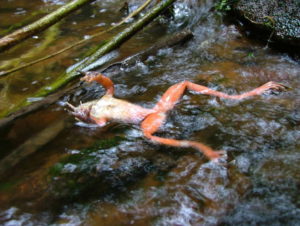03
Jan
Herbicide Atrazine Affects Estuarine Phytoplankton Productivity, Threatens Aquatic Life
(Beyond Pesticides, January 3, 2017) A study published in December 2016 in Environmental Contamination and Toxicology, entitled The Effect of Atrazine on Louisiana Gulf Coast Estuarine Phytoplankton, finds that phytoplankton in estuaries in close proximity to agricultural operations are less productive than phytoplankton in an uncontaminated environment. The study examines three different estuaries of the Mississippi river in Louisiana and also evaluates microcosms with different concentrations of atrazine. Phytoplankton, incredibly important to estuary ecosystems and aquatic life, are an integral part of the aquatic food web and ultimately critical to the wild seafood market. As photosynthetic microorganisms, phytoplankton harness the sun’s energy for metabolism and create as a byproduct of photosynthesis dissolved oxygen, which oxygen-breathing sea life require.
For the study, the researchers created microcosms, or large containers that are able to closely mimic ecosystems, so that they can observe the effects of independent variables. On average, phytoplankton in the microcosms are less productive at producing chlorophyll a in the presence of atrazine. The microcosm study design is important because it is difficult to separate and measure the effects of chemicals like atrazine in the environment, given the range of potential causes of phytoplankton decline. A variety of factors, like freshwater discharge rates, precipitation, and seasonal changes, make it difficult to adequately measure the variables that affect phytoplankton populations. The researchers call for a long-term study to gain a greater understanding of the scope of the atrazine contamination problem. The ongoing concern of the researchers is driven by the fact that the herbicidal properties of atrazine could have similar effects on phytoplankton as it does on terrestrial plants, since they both rely on photosynthesis for metabolism.
Atrazine is the second-most widely used pesticide in the United States, with over 73 million pounds applied to agricultural fields each year. Once applied to farms, precipitation and other factors cause the chemical to runoff into surrounding streams and groundwater aquifers. In 2012, water utilities settled a class action lawsuit against the manufacturer of atrazine, Syngenta, to clean up atrazine contamination of its treated water.
Even at levels established as “safe” or acceptable by EPA drinking water standards, atrazine is linked to endocrine-disrupting effects. EPA is not adequately assessing the effects of atrazine by using high dose testing models, which are not appropriate for hormonally-active substances that often show effects at minute doses of endocrine disruptors. Studies by Tyrone Hayes, Ph.D., University of California, Berkeley, and others have shown that concentrations as little as 0.1ppb impact hormone function in organisms and turns tadpoles into hermaphrodites — organisms with both male and female sexual characteristics. Research also finds that atrazine interferes with mammary gland development in the breast of mammals and is linked to certain birth defects like gastroschisis and choanal atresia, which are significantly increased for pregnant women with high levels of atrazine exposure in agricultural areas and from urban streams. The European Union and many countries have banned atrazine, however EPA continues to put U.S. citizens and the environment in harm’s way, allowing nonstop use of this toxic chemical.
in April 2016, EPA released a draft ecological risk assessmen that finds atrazine poses unacceptable risks to fish, amphibians, aquatic invertebrates, and even birds, reptiles and mammals. The assessments evaluated risks to animals and plants, including amphibians, birds, mammals, fish, reptiles, aquatic invertebrates, aquatic plant communities, and terrestrial plants. EPA concludes, “aquatic plant communities are impacted in many areas where atrazine use is heaviest, and there is potential chronic risks to fish, amphibians, and aquatic invertebrate in these same locations. In the terrestrial environment, there are risk concerns for mammals, birds, reptiles, plants and plant communities across the country for many of the atrazine uses.” Levels of concerns were exceeded by as much as 200-fold for some organisms!
The phytoplankton study is another reminder that atrazine is proven to have an effect on aquatic ecosystems. In July 2016, California’s Office of Environmental Health Hazard Assessment (OEHHA) announced that atrazine, its chemical cousins propazine and simazine, and its breakdown triazine compounds would be added to the list of chemicals known to the state to cause reproductive toxicity for purposes of the state’s Proposition 65.
The evidence is clear. Atrazine harms wildlife, persists in soils, and moves easily through waterways. Take Action: Sign the petition to urge EPA to end the use of atrazine. In order to protect human and ecological health, the agency should take immediate action to eliminate this chemical from our environment!
Source: The Effect of Atrazine of Effect of atrazine on Louisiana Gulf Coast Estuarine Phytoplankton










